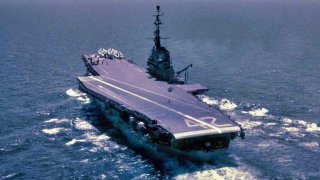USS Franklin D. Roosevelt: The Aircraft Carrier That Had Just One Mission
The USS Franklin D. Roosevelt (CV-42), affectionately known by a variety of nicknames including “Swanky Franky,” “Foo-De-Roo,” and “Rosie,” initially christened the USS Coral Sea, was renamed in honor of the late President Franklin D. Roosevelt by President Harry Truman. Despite being laid down during World War II, the carrier missed combat in the conflict, only being commissioned after the war's end.
Summary: The USS Franklin D. Roosevelt (CV-42), affectionately known by a variety of nicknames including “Swanky Franky,” “Foo-De-Roo,” and “Rosie,” initially christened the USS Coral Sea, was renamed in honor of the late President Franklin D. Roosevelt by President Harry Truman. Despite being laid down during World War II, the carrier missed combat in the conflict, only being commissioned after the war's end. Notably, it became the first American carrier to operate a jet-powered aircraft in 1946. Throughout the 1940s and early 1950s, it primarily served near the East Coast and in the Mediterranean. In 1952, it underwent a significant reconstruction at Puget Sound Naval Shipyard, enhancing its capabilities but also increasing its displacement significantly. Though it supported minor operations, such as evacuating American citizens from Cuba in 1958, it didn't see much combat. By the late 1970s, it was considered outdated and was decommissioned in 1977, with preservation efforts failing, leading to its scrapping. The carrier had one mission: defeat the enemy.
A Look Back: The USS Franklin D. Roosevelt's Journey Through History
The USS Franklin D. Roosevelt (CV-42) was the first aircraft carrier named for a president of the United States. To her crew, the Midway-class carrier was known by a variety of nicknames, including “Swanky Franky,” “Foo-De-Roo,” and especially, “Rosie.”
But Rosie was never meant to be named after Roosevelt at all. The carrier was christened on April 29, 1945, under a different name: the USS Coral Sea. In early May, President Harry Truman approved the secretary of the Navy’s recommendation that the Coral Sea be renamed the Franklin D. Roosevelt in honor of the former president, who had died a month prior and who had once served as assistant secretary of the Navy.
USS Franklin D. Roosevelt Missing the Action Aircraft Carrier
The Franklin D. Roosevelt was laid down at the height of World War II, but the carrier would not be commissioned until Oct. 29, 1945, about two months after the Japanese capitulation marked the war’s end.
In 1946, the ship earned an early distinction. It became the first American carrier to operate a jet-powered aircraft when Lt. Comm. James Davidson made a series of take-offs and landings in a McDonnell XFD-1 Phantom.
The Franklin D. Roosevelt spent most of the 1940s lingering near the East Coast and in the Mediterranean, as she was too big to pass through the Panama Canal. In 1952, however, the Roosevelt rounded Cape Horn and sailed for Puget Sound Naval Shipyard, where she would undergo extensive reconstruction. During the reconstruction, the Roosevelt was decommissioned.
The work was extensive, costing $48 million at the time. The Franklin D. Roosevelt received an enclosed hurricane bow, as well as one C-11-2 and two C-11-1 steam catapults, plus a reinforced arresting gear, an enlarged bridge, a mirror landing system, and a 482-foot angled flight deck. SPS-8 height-finding radar and SPS-12 air search radar were mounted on a new tubular mast.
That’s not all.
The aft elevator was moved over to the starboard deck edge, while the forward elevator was expanded, and all of the ship’s elevators were improved to be able to lift 75,000 pounds. The Franklin D. Roosevelt’s fuel bunkerage was increased from 350,000 gallons to 450,000 gallons, and the ship’s displacement increased from 51,000 tons to 63,400 tons.
To compensate for the boat’s increased weight, multiple 5-inch Mark 16 anti-aircraft guns were removed, as was the 3,200-ton armor belt. Hull blisters were added to handle the heavier load.
On April 6, 1956, after nearly four years of construction, the Franklin D. Roosevelt was recommissioned.
Timing prevented the carrier from participating in much combat. In 1958, the Roosevelt supported the USS Kleinsmith in evacuating 56 American citizens from Cuba during the height of the Cuban Revolution. That is about as involved in foreign conflict as the carrier ever got, although it did have indirect involvement in the 1973 Yom Kippur War, during which the Roosevelt served as a transit landing field for aircraft being delivered to Israel.
In all, the Roosevelt doesn’t have as storied a history as many of her contemporaries. By the late 1970s, the ship was in poor condition and considered the least capable and least modern of the Midway carriers; she was decommissioned in 1977. Efforts to preserve the Roosevelt as a museum ship in New York City failed and she was scrapped.
About the Author: Harrison Kass
Harrison Kass is a defense and national security writer with over 1,000 total pieces on issues involving global affairs. An attorney, pilot, guitarist, and minor pro hockey player, Harrison joined the US Air Force as a Pilot Trainee but was medically discharged. Harrison holds a BA from Lake Forest College, a JD from the University of Oregon, and an MA from New York University. Harrison listens to Dokken.


